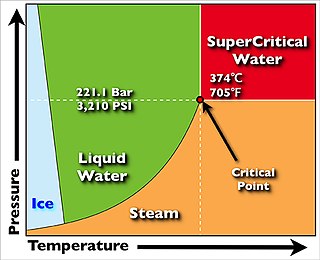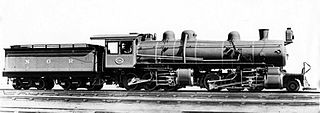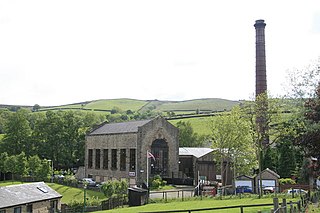Related Research Articles

A boiler is a closed vessel in which fluid is heated. The fluid does not necessarily boil. The heated or vaporized fluid exits the boiler for use in various processes or heating applications, including water heating, central heating, boiler-based power generation, cooking, and sanitation.

A safety valve is a valve that acts as a fail-safe. An example of safety valve is a pressure relief valve (PRV), which automatically releases a substance from a boiler, pressure vessel, or other system, when the pressure or temperature exceeds preset limits. Pilot-operated relief valves are a specialized type of pressure safety valve. A leak tight, lower cost, single emergency use option would be a rupture disk.

The London and North Eastern Railway LNER Gresley Classes A1 and A3 locomotives represented two distinct stages in the history of the British 4-6-2 "Pacific" steam locomotives designed by Nigel Gresley. They were designed for main line passenger services and later express passenger services, initially on the Great Northern Railway (GNR), a constituent company of the London and North Eastern Railway after the amalgamation of 1923, for which they became a standard design. The change in class designation to A3 reflected the fitting to the same chassis of a higher pressure boiler with a greater superheating surface and a small reduction in cylinder diameter, leading to an increase in locomotive weight. Eventually all of the A1 locomotives were rebuilt, most to A3 specifications, but no. 4470 was completely rebuilt as Class A1/1.

A boiler explosion is a catastrophic failure of a boiler. There are two types of boiler explosions. One type is a failure of the pressure parts of the steam and water sides. There can be many different causes, such as failure of the safety valve, corrosion of critical parts of the boiler, or low water level. Corrosion along the edges of lap joints was a common cause of early boiler explosions.

A fusible plug is a threaded cylinder of metal usually of bronze, brass or gunmetal, with a tapered hole drilled completely through its length. This hole is sealed with a metal of low melting point that flows away if a pre-determined, high temperature is reached. The initial use of the fusible plug was as a safety precaution against low water levels in steam engine boilers, but later applications extended its use to other closed vessels, such as air conditioning systems and tanks for transporting corrosive or liquefied petroleum gasses.
The Northern Counties Committee (NCC) Class S2 was a solitary two-cylinder compound 2-4-4T steam locomotive that was introduced for service on the 3 ft narrow gauge railways of County Antrim in north-east Ireland. It was heavily rebuilt from a BNCR Class S locomotive by the addition of a standard gauge boiler.

Steamboats on the Columbia River system were wrecked for many reasons, including striking rocks or logs ("snags"), fire, boiler explosion, or puncture or crushing by ice. Sometimes boats could be salvaged, and sometimes not.

A potato cannon is a pipe-based cannon that uses air pressure (pneumatic), or combustion of a flammable gas, to launch projectiles at high speeds. They are built to fire chunks of potato, as a hobby, or to fire other sorts of projectiles, for practical use. Projectiles or failing guns can be dangerous and result in life-threatening injuries, including cranial fractures, enucleation, and blindness if a person is hit.

The Grover Shoe Factory disaster was an industrial explosion, building collapse and fire that killed 58 people and injured 150 when it leveled the R. B. Grover shoe factory in Brockton, Massachusetts on March 20, 1905. Following a boiler explosion, the four-story wooden building collapsed and the ruins burst into flames, incinerating workers trapped in the wreckage.

A supercritical steam generator is a type of boiler that operates at supercritical pressure and temperature, frequently used in the production of electric power.

Henry Eckford was a small passenger-cargo steamboat built in New York in 1824. She was the first steam vessel in the world to be installed with a compound engine, almost fifty years before the technology would become widely adopted for marine use.

In what was characterized as the worst disaster in the Yukon River's history, the sternwheeler Columbian exploded and burned at Eagle Rock, Yukon, Canada, on 25 September, 1906, killing six men. The steamer was carrying a crew of twenty-five men and a full cargo, including cattle and three tons (2.722 t) of blasting powder destined for the Tantalus coal mine, thirty miles (48 km) downriver.

The South African Railways Class MA 2-6-6-0 of 1909 was a steam locomotive from the pre-Union era in the Natal Colony.

The South African Railways Class MH 2-6-6-2 of 1915 was an articulated Mallet-design steam locomotive.

Bancroft Shed was a weaving shed in Barnoldswick, Lancashire, England, situated on the road to Skipton. Construction was started in 1914 and the shed was commissioned in 1920 for James Nutter & Sons Limited. The mill closed on 22 December 1978 and was demolished. The engine house, chimneys and boilers have been preserved and maintained as a working steam museum. The mill was the last steam-driven weaving shed to be constructed and the last to close.
The Peckfield pit disaster was a mining accident at the Peckfield Colliery in Micklefield, West Yorkshire, England, which occurred on Thursday 30 April 1896, killing 63 men and boys out of 105 who were in the pit, plus 19 out of 23 pit ponies.

Mill Point Settlement Site is a heritage-listed former settlement at Elanda Point at Lake Cootharaba in Como, Shire of Noosa, Queensland, Australia. It was built from c. 1869 to the 1940s. It was added to the Queensland Heritage Register on 6 April 2005.
References
- 1 2 3 4 5 6 Durwin, Joe (August 24, 2015). "Sagas of the Shire: The Morewood Lake Disaster". iBerkshires.com. Retrieved 23 February 2022.
- 1 2 3 "Boiler Explosion Kills 16". The New York Times. December 30, 1910.
- 1 2 "The Pittsfield Boiler Explosion". The Boiler Maker. February 1911. Retrieved 23 February 2022.
- ↑ "17th Victim of Explosion". The Boston Daily Globe. December 30, 1910.